
The waste management industry is an essential support industry that helps Canadian businesses operate and manage the impact to the environment without depriving future generations. ACUTE helps workers handling hazardous materials to return safely to their families at the end of the day by offering industry-proven training to reduce injuries and casualties. Contact our qualified professionals to get started today. This article looks at the waste management industry’s hazards and focuses on the challenges specifically of working at heights, in confined spaces, and with hazardous materials. The best way to manage hazards is to have a comprehensive safety program backed by quality hands-on safety training.
Waste Management Industry Challenges
The primary challenge that is faced by the waste management globally is “How do we handle our discarded resources in ways which do not deprive future generations of some, if not all, of their value?” (United Nations Environment Program presentation). With that overarching goal, waste management professionals work with heightened risks of having to manage the cradle-to-grave lifecycle of an extensive list of hazardous materials. Stats Can relays that “The services provided by the waste management industry include the collection and transportation of waste and materials destined for recycling (including composting), the operation of non-hazardous and hazardous waste disposal facilities, the operation of transfer stations, the operation of recycling and composting facilities and the treatment of hazardous waste”. The largest sector within the waste management industry is collection and transportation, amounting to $45 per capita in StatsCan survey conducted in 2010. Additionally, a study conducted in the Bay Area showed that 70% of workers experienced illness or injury from waste management activities relating to dust.
Accessibility of waste and maintenance – Waste management professionals must scale places of varied heights to replace aging components of electric or cell towers and to service assets like oil rigs. Working at heights is a challenge for waste management professionals as they seek to manage safety and environmental impact while also being exposed to the risk of climate and elevation.
Confined spaces – These areas are typically created to manage substances like heat, chemicals, and combustion agents which pose hazards to professionals. Waste management is faced with twice the hazard, not only needing to work in a confined space but to also manage waste and by-products.
Spills – The industry seeks to limit and control the exposure of hazardous materials so as to limit the environmental and health damage caused by waste materials and run-off from production and operations. Spills and containment are a major area of focus for successful waste management control.
Below we will dig into these common industry challenges along with providing helpful training that can assist your staff in managing both their safety and your team’s well being.
Getting quality training shouldn’t be risky. See what ACUTE customers are saying about our training:
“I’ve been using ACUTE for a number of years now. What started with lift truck and crane training has expanded to have them providing most of my H&S disciplines. The customer service is the best I have encountered; they work with me and accommodate my schedules for multiple locations; our employees really like the trainers and content is the best and most relevant to my needs as I have ever found. I recommend ACUTE to everyone looking for competent, professional training services.”
-Rob
For more reviews, click here.
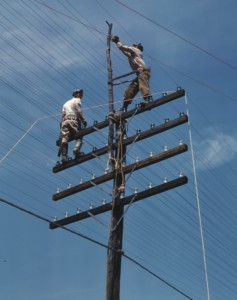 Working at Heights Challenges
Working at Heights Challenges
Aging components located in oil rigs, electrical towers, and cell towers require replacement and proper disposal. The weight and elevation of these components creates unique risks for the waste management industry:
- Detection of harmful chemicals – Because of the accessibility of remote or elevated locations, when mercury is leaked from instrumentation tools or when batteries have become corrosive, professionals may unknowingly face additional hazards before they enter the premise.
- Injury from overexertion – Based on the weights of disposable waste components professionals may need additional equipment and training to properly handle this replacement and recycling procedure.
- Decommission of aging components – The complexity of managing environmental waste while removing aging components from industrial assets can increase the complexity and hazard of working at heights.
Fundamental Courses to Help Turn Theory into Hands-On Safety Practices
Waste Management professionals need the best Working at Heights training to ensure their personal safety and environmental sustainability outcomes. Here are just a few of the courses ACUTE offers to help waste management professionals stay on top of working at heights hazards.
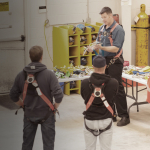
Working At Heights Training Course – Approved by The Chief Prevention Officer of Ontario
In this course, you will learn working at heights legislation, working at heights hazards, fall prevention strategies and systems, fall protection systems, safe work strategies, and how to select and use the proper fall protection equipment.
To view the Ontario Working at Heights standards and requirements, click here.
This course is 8 hours in length (1 day)
Learn more about this course – click here
 Waste Management Hazards within Confined Spaces
Waste Management Hazards within Confined Spaces
Waste management employees may be required to enter into confined spaces. Here are hazards associated with the confined spaces that employees need to navigate:
- Moulds and bacteria – Due to a lack of sunlight and moisture, mould can require additional procedures for proper disposal of corrupted materials, exposing workers to greater health risks.
- Noise – Due to the constant movement of machinery for the containment and disposal of waste, professionals are at risk of damaging their hearing if not properly trained and utilizing effective PPE.
- Confined space hazards in industrial machinery or waste management assets – Due to the tight containment mechanisms in machinery such as a packing and loader vehicle, injury and illness can ensue if equipment is not operated correctly.
- Communicable diseases from rodents and insects – Due to the nature of waste, rodents or insects may cause additional hazards by exposing professionals to diseases.
- Waste storage – As waste accumulates in a storage or container, proper disposal becomes challenging as space is reduced. This means less lighting, oxygen, and communication channels available in some cases.
- Ergonomics – Within the supply room or when replacing a furnace, harmful gas/agent leaks must be managed despite limited space, leading to a confined range of motion.
Get Staff out of a Tight Spot with ACUTE’s Confined Space Training
With the advanced technology and requirements for numerous forms of chemicals, energy, and other substances, there are unique confined space challenges in the waste management industry. Here is the industry-proven training that can help your waste management employees stay safe. Safety. It’s all that we do.

Confined Space Entry Awareness Training
This training program will familiarize participants with the requirements of Ontario Regulation 632/05 – Confined Spaces. Furthermore, the training program is intended to provide entrants, attendants, and competent persons the skills and training required to recognize confined space entry risks and to establish measured corresponding controls. Participants will have the opportunity to become familiar with, inspect, and use Confined Space Entry (CSE) access equipment and air quality instrumentation.
This course is 8 hours in length (1 day).
Learn more about this course – click here
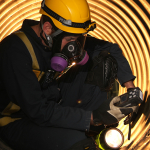 Confined Space Competent Person Training
Confined Space Competent Person Training
This course is for confined space program administrators and those directly responsible for supervising confined space operations, as they require deeper insight and understanding with respect to confined space hazards that may exist or accumulate in a space. These hazards exist or accumulate because of the confined space’s configuration, contents, location, and the work activities to be performed in the space. Those overseeing confined space entry, either directly or indirectly, must be aware of suitable corresponding control measures to keep confined space workers safe. ACUTE can customize its confined space entry courses to provide equipment-specific, relevant training to its clients.
This course is 16 hours in length (2 days).
Learn more about this course – click here
This training program builds on the content of the Confined Space Entry Awareness course to train participants on safety considerations and methodology to safely perform a rescue from a confined space.
This course is 8 hours in length (1 day).
Learn more about this course – click here
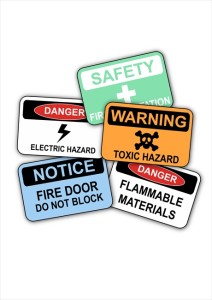 Challenges of Hazardous Materials and Substances in the Waste Management Industry
Challenges of Hazardous Materials and Substances in the Waste Management Industry
- Production line run-off – These include metal waste, plastics, and chemical byproducts of production plants.
- Radiation – Found in instrumentation equipment and heavy machinery. Exposure can cause deterioration of human health without proper protection.
- Toxic chemicals – As part of production or refinement processes, these by-products require careful coordination and management to ensure lives and the environment aren’t impacted.
- Dust particles – As part of disposal, lots of materials and debris may be moved enabling airborne chemicals to make contact with skin and a professional’s respiratory system.
- Electrical energy – Professionals are exposed to this hazardous energy in places like exhaust systems.
- Heat – This hazard is often found in areas like industrial refinement, metal industries, furnace rooms, and more. Proper management of this hazard is important for both employees and also the transportation of assets.
Get Mastery in Managing Hazardous Materials and Spills with ACUTE Training
Spill Response training will cover the legislative requirements for spill reporting and cleanup. Participants will be taught practical strategies to both prevent and safely contain spills that occur in the workplace. Training programs are routinely customized to reflect client sites and products.
This course is 12 hours in length (less than 2 days).
Learn more about this course – click here
Other great courses to help improve your competency with hazardous materials:
ARC Flash and Electrical Safety
 Wear and Tear Injuries and Motor Vehicle Risks
Wear and Tear Injuries and Motor Vehicle Risks
Waste disposal processes have been optimized with technology, though there are still piecemeal garbage and disposal items that require manual lifting or repetitive motions. Ensure your employees don’t get exposed needlessly to the age old occupation hazards of overexertion or muscle injuries. The other prominent hazard in the collection and transportation of waste materials is accidents on the road. Careful monitoring of road conditions and worker safety is important in reducing the number of incidents from the source of waste generation to the destination of disposal
Waste management staff of all levels should receive safety awareness training, helping to ensure safety is prioritized and managed effectively at all levels of the organization from managers to staff. The first step is ensuring champions or leaders are in place to drive a comprehensive workplace safety management program.
Worker Basic Occupational Health and Safety Awareness
This training program has been designed to inform workers of the various safe work expectations, obligations, and prohibitions that are communicated in the provisions of the OHSA. This training program also focuses on the health and safety resources and the individual rights that workers may use to maintain their personal workplace safety.
This course takes only 3 hours to complete.
 Learn more about this course click here.
Learn more about this course click here.
Supervisor Basic Occupational Health and Safety Awareness.
This training program will help prepare supervisors for their critical role as a competent person in the workplace charged with the duty of ensuring every reasonable precaution is undertaken to keep workers safe.
This course only requires 4 hours to complete (half a day).
Supervisor Basic Occupational Health and Safety Awareness.
Get Hands-On Training Tailored for the Waste Management Industry
ACUTE’s team is knowledgeable of the ways waste management operations can stretch staff to overexert or to work hastily, meaning health and safety training must be thorough and engaging enough that it becomes part of the staff’s regular routine. Empowering your waste management and maintenance staff with compelling training and that helps their day-to-day work is what ACUTE is all about. ACUTE focuses on safety to ensure workers are effectively protected and equipped to navigate all the hazards they may face. ACUTE not only meets government requirements but strives to provide quality, hands-on, and industry-tailored training to each of their clients. ACUTE has a cutting-edge training facility that has hosted several provincial and federal agencies. Here are ways that ACUTE goes beyond government compliance in Ontario health and safety training.
- Open Door Instructor-Student Partnersh
 ip – ACUTE’s training services emphasize client participation. Staff foster relationships with clients and serve as a touchstone for advice moving forward.
ip – ACUTE’s training services emphasize client participation. Staff foster relationships with clients and serve as a touchstone for advice moving forward. - Serving Your Team and Industry – With a vast array of clients in the mining, manufacturing, construction, health, academic, and government sectors, ACUTE brings the best safety practices from across the spectrum to your workplace.
- 100 Years Combined Experience – ACUTE provides comprehensive health and safety training, on-site safety services, and consulting services. With over 100 years of combined experience, our staff offers more than theoretical or abstract ideas. ACUTE offers solutions.
- Track Record of Success – ACUTE is rated 4.9/5 stars on Google reviews, demonstrating a commitment to our clients, quality, and a passion for training.
Contact us today for quality training in your workplace or on-site at ACUTE’s proven training facilities!
ACUTE is located in Waterloo, Ontario, and services customers from cities such as Toronto, Mississauga, Brampton, Hamilton, Milton, Kitchener, London, and Guelph, and other cities from across Ontario.


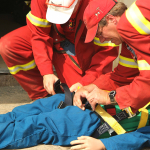
 Spill Response Training
Spill Response Training